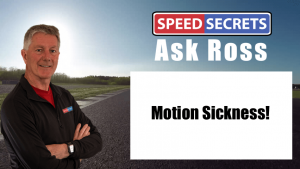 Q: “At the age of 47, I’ve just gotten into endurance racing (24 hours of Lemons). So far, I’m quickest on the team over a single lap, but my stint time is among the shortest because I get car sick while driving. This first happened at an open lapping day while riding passenger in a friend’s car. I got sick almost immediately. That was the first time I’d had motion sickness of any kind in decades. Later that day, it happened while I was driving for the first time ever. Fast forward to the race and I was only able to push to a 90-minute stint, but not longer. During that 90 minutes I had the patches on behind my ears, the pressure point bands on my wrists, and had taken some ginger prior to getting in the car. I wasn’t going to do Dramamine or anything like that for fear of drowsiness and other side effects. Is this common? Any thoughts or tips on how I can deal with this in the future?”
Q: “At the age of 47, I’ve just gotten into endurance racing (24 hours of Lemons). So far, I’m quickest on the team over a single lap, but my stint time is among the shortest because I get car sick while driving. This first happened at an open lapping day while riding passenger in a friend’s car. I got sick almost immediately. That was the first time I’d had motion sickness of any kind in decades. Later that day, it happened while I was driving for the first time ever. Fast forward to the race and I was only able to push to a 90-minute stint, but not longer. During that 90 minutes I had the patches on behind my ears, the pressure point bands on my wrists, and had taken some ginger prior to getting in the car. I wasn’t going to do Dramamine or anything like that for fear of drowsiness and other side effects. Is this common? Any thoughts or tips on how I can deal with this in the future?”
A: You’re not alone, as I’ve heard from some other drivers who get motion sickness. The first time I raced the Daytona 24-Hour race, one of my co-drivers got motion sick to the point of, well, you guessed it. That made it very unpleasant to be the next driver in line after him! I’ve also heard from quite a few instructors who get motion sickness when riding in the passenger seat.
Beyond what you’ve already done, here are a few things you might try/add:
- The further ahead you look, the less likely the motion will impact you. I’ve only felt motion sickness twice in my life while riding in the passenger seat on a track, and each time I realized that I’d been very focused on just in front of the car to check on the line my student was driving. As soon as I realized this, I deliberately looked further ahead, and the feeling went away.
- To the “look further ahead” advice, I also added a technique from martial arts called “centering,” where you touch your tongue to the roof of your mouth (up in the part where peanut butter sticks). There’s an acupressure point there that triggers balance in our bodies (which is why it’s used in martial arts), and that can help with motion sickness.
- Breathe. Deliberately breathe deeper and longer. Sometimes motion sickness is triggered by restricted breathing.
- Build up a tolerance. This will be difficult for you to fit into your race event schedule, but in the ideal world you’d drive for long enough (just before your equilibrium is knocked out of balance and you begin to feel motion sickness), and stop. After a few hours (or maybe even a day, and especially after laying down for a while), you’d go back out and drive for about 5 to 10 minutes longer than you did the first time, and repeat the break routine; then do it again and drive for another 5 to 10 minutes longer; and so on, until you’ve built up a tolerance for the motion.
I recommend that you combine all of these, where you can. Focusing on looking further ahead, while centering (tongue touching the roof of your mouth) and breathing are easy to combine, and I suspect that will help. If you were able to work in a routine of building up a tolerance while doing all of these, too, that would help even more.
For sure, the worst thing you can do is try to drive through motion sickness, because it only gets worse and reinforces the belief and mental programming that this is going to happen. I really think that if you focus on your vision, centering, and breathing, it will help.
